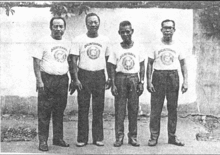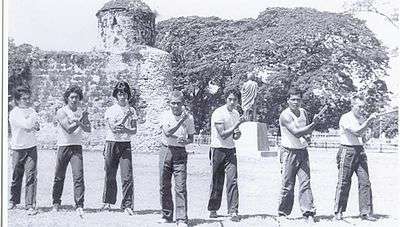Balintawak Eskrima
 Original Balintawak club members from left to right: José Villasin, Johnny Chiuten, Venancio Bacon, and Teofelo Velez. | |
| Also known as | Balintawak Eskrima |
|---|---|
| Focus | Stick fighting |
| Country of origin |
|
| Creator | Venancio "Anciong" Bacon |
| Famous practitioners |
Bobby Tabimina Bobby Taboada Jose Villasin Teofilo Velez Teodoro Buot Sam Buot Crispulo "Ising" Atillo Timoteo Maranga Arnulfo Mongcal Nene Gaabucayan Ver Villasin Chito Velez Monie Velez Eddie Velez Nicomendes "Nick" Elizar Ben Marapao Carlo "kaloy" Campaña Danny Casio Wison Ceniza Jun Marapao Oliver Maguyon |
| Official website | balintawak.org |

Balintawak Eskrima or Balintawak Arnis is a Filipino Martial Art developed by Venancio Bacon in the 1950s to enhance and preserve the combative nature of arnis which he felt was being watered down by other styles of Philippine martial arts. It is named after a small street in Cebu where it was founded.
History
In 1932, the Doce Pares Club was formed, composed of eskrimadors from the Saavedra and the Cañete family. This was headed by Lorenzo Saavedra. Venancio Bacon was among the first members of the Doce Pares Club and became one of its best fighters. According to an interview in Bladed Hand, a Filipino documentary about Filipino martial arts, Grandmaster Ciriaco "Cacoy" Cañete said that Bacon was among the best fighters in the Doce Pares Club, second only to "Doring" Saavedra.
Bacon eventually left the Doce Pares Club, citing skepticism of the system's combat effectiveness. Per information provided by T. Buot, the reason why V. Bacon did not rejoin the Doces Pares group as he felt that his alone vote would not have any weight against the Canete family. In the 1950s, together with Delfin López Timoteo Maranga and others, Bacon established a new club, calling it the Balintawak Street Self-Defense Club. The newly formed club started training in the backyard of a watch shop owned by Eduardo Baculi, one of Bacon’s students, in the titular street, a small side street in the Colon St. area.
Ted Buot was the only student of GM Bacon to teach at his club in the back of the watch store. T. Buot would be teaching and Bacon would show up and Buot would hand him his stick to teach with. When Bacon was done he would hand the stick back to Buot and leave. During the 1950s and 1960s, eskrimadors from various camps, mainly Doce Pares and Balintawak, tested each other’s skills in all-out challenges, sometimes by arrangement and sometimes by ambush, often resulting in injuries and, more rarely, deaths. In one such ambush, Venancio Bacon was caught in the dark while walking to his home in Labangon, and killed his assailant by snapping his spine.[1] Bacon was tried and imprisoned, with the judge ruling that Bacon’s martial arts skills could be considered a lethal weapon[1] and should have been used with restraint. While in prison, he recruited further students, including Bob Silver Tabimina. Upon his release on parole in the mid-1970s, Bacon returned to Cebu and Balintawak. He did not resume leadership, but did regularly attended training sessions conducted by José Villasin and Teofilo Velez until his death a few years later. Per Buot, both Bacon and Buot were always welcome at many of the Doces Pares homes.
Curriculum
Bacon developed single stick techniques. With the help of Villasin he developed and optimized his techniques based upon single stick work. Villasin, under the tutelage of Bacon, developed its basic strike and defense patterns which are now used by most Balintawak practitioners. This pattern forms the basis from which a practitioner can develop basic, semi-advanced, and advanced movements.[2] All techniques must be demonstrated with power, control, and body mechanics. There has been some discussion that Velez brought the idea of the patterns to Villasin and shared it with him. This does not detract at all from the contributions Villasin made within his club and the lineage that comes from his instruction.
The Buot lineage teaches in the same methodology as Bacon originally taught. This is not a claim of being better, it is just a statement as the pattern training above could easily be argued to be a better system to reaching more people. This is mentioned here for historical reference and to list the minority training as referenced above.
In Balintawak, the stick is only used to enhance and train the individual for bare hands fighting, and to achieve perfection in the art of speed, timing and reflexes necessary to acquire defensive posture and fluidity in movement. It aims to harness one’s natural body movement and awaken one’s senses to move and react. It guarantees its practitioner to experience a revelation in the fundamentals of street fighting.[3]
Systematization
Later, some of Bacon's successors soon began to systematize the Balintawak curriculum. One was José Villasin, a self-defense instructor at University of Visayas who grouped the techniques in various categories so his students could master one set of techniques and then move to the next set of related techniques. At this point, several distinct schools of Balintawak emerged teaching the "grouping method".
While those like Villasin taught using the "grouping method", some of Bacon’s students and his associates continued to teach in the old method of random instruction.[4]
Today, there are a number of Balintawak groups teaching different versions of the system. Most instructors use the "grouping" method for teaching the techniques while others continue to teach in the traditional way, as Bacon used to teach.
Influence
The principles and concepts of Balintawak have, however, found their way into many different Filipino martial arts. Most notable is Modern Arnis, founded by Remy Presas who studied Balintawak under Arnulfo Mongcal.[5] Mongcal introduced Presas to Maranga who trained him for a while and then introduced him to Bacon. The reason Mongcal should be called out is that he was left handed as was Presas.
Tat Kun Tao is created by Joe Go, one of Venancio Bacon's earliest students. This is a unarmed form of Balintawak with influences from Chinese martial arts such as Tai Chi and Five Ancestors Boxing.
Gallery
Further reading
- Nepangue, Ned R. (2007). Cebuano Eskrima Beyond the Myth. Xlibris Corporation. ISBN 978-1-4257-4622-3.
- Macachor, Celestino C. (2007). Cebuano Eskrima Beyond the Myth. Xlibris Corporation. ISBN 978-1-4257-4622-3.
- Wiley, Mark V. (1997). Filipino Martial Culture. Tuttle Publishing. ISBN 0-8048-2088-0.
- Wiley, Mark V. (2000). Filipino Fighting Arts: Theory and Practice. Tuttle Publishing. ISBN 0-86568-180-5.
- Russell, John. VMA Instructors. Retrieved 8 July 2013.
- "VMA Instructors The Balintawak System of Arnis-Escrima". Archived from the original on 2010-03-16. Retrieved 8 July 2013.
- Buot, Sam (2015). Balintawak Eskrima. Tambuli Media. ISBN 978-069-231-2995.
See also
References
- 1 2 "Eskrimadors - A Filipino Martial Arts Documentary".
- ↑ Thurston, B. (2007). Curriculum Guide for Balinatwak Arnis. Balintawak Arnis. pp. 3–7.
- ↑ ""Simhota Ko Dong" — Anciong Bacon". Retrieved 8 July 2013.
- ↑ Russell, John. "Balintawak Arnis/Escrima". Archived from the original on 14 September 2009. Retrieved 2009-08-23.
- ↑ "History of the Balintawak Style". Retrieved 2009-08-23.
External links
- Archive footage of Anciong Bacon training with his students in Fort San Pedro
- Balintawak Sugbu Traditional Villasin Fighting System Consolacion Cebu - Master Carlo "Kaloy" Campaña
- Filipino Martial Arts Digest Special Edition 2007: Buot Balintawak. Interviews with Teddy and Sam Buot
- Kritters Group Balintawak - Marapao Aggression System (KGB-MAGGS)
- RED Balintawak - GM Danilo Casio

